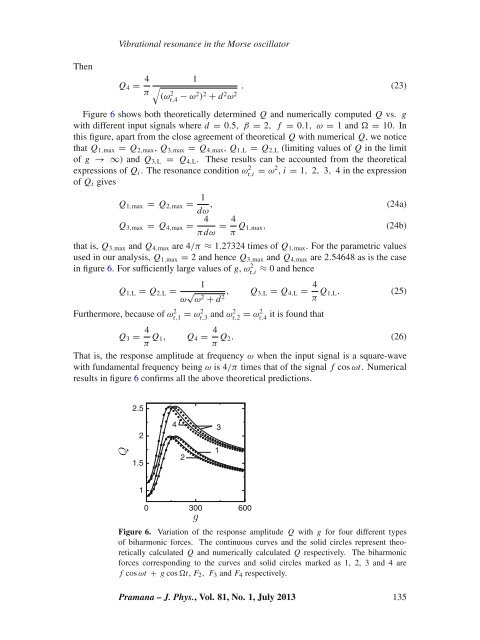Vibrational resonance in the Morse oscillator - Indian Academy of ...
Vibrational resonance in the Morse oscillator - Indian Academy of ...
Vibrational resonance in the Morse oscillator - Indian Academy of ...
Create successful ePaper yourself
Turn your PDF publications into a flip-book with our unique Google optimized e-Paper software.
<strong>Vibrational</strong> <strong>resonance</strong> <strong>in</strong> <strong>the</strong> <strong>Morse</strong> <strong>oscillator</strong><br />
Then<br />
Q 4 = 4 π<br />
1<br />
√(ω 2 r,4 − ω2 ) 2 + d 2 ω 2 . (23)<br />
Figure 6 shows both <strong>the</strong>oretically determ<strong>in</strong>ed Q and numerically computed Q vs. g<br />
with different <strong>in</strong>put signals where d = 0.5, β= 2, f = 0.1, ω= 1 and = 10. In<br />
this figure, apart from <strong>the</strong> close agreement <strong>of</strong> <strong>the</strong>oretical Q with numerical Q, we notice<br />
that Q 1,max = Q 2,max , Q 3,max = Q 4,max , Q 1,L = Q 2,L (limit<strong>in</strong>g values <strong>of</strong> Q <strong>in</strong> <strong>the</strong> limit<br />
<strong>of</strong> g → ∞) and Q 3,L = Q 4,L . These results can be accounted from <strong>the</strong> <strong>the</strong>oretical<br />
expressions <strong>of</strong> Q i . The <strong>resonance</strong> condition ωr,i 2 = ω 2 , i = 1, 2, 3, 4 <strong>in</strong> <strong>the</strong> expression<br />
<strong>of</strong> Q i gives<br />
Q 1,max = Q 2,max = 1<br />
dω ,<br />
(24a)<br />
Q 3,max = Q 4,max = 4<br />
πdω = 4 π Q 1,max,<br />
(24b)<br />
that is, Q 3,max and Q 4,max are 4/π ≈ 1.27324 times <strong>of</strong> Q 1,max . For <strong>the</strong> parametric values<br />
used <strong>in</strong> our analysis, Q 1,max = 2 and hence Q 3,max and Q 4,max are 2.54648 as is <strong>the</strong> case<br />
<strong>in</strong> figure 6. For sufficiently large values <strong>of</strong> g, ωr,i 2 ≈ 0 and hence<br />
1<br />
Q 1,L = Q 2,L =<br />
ω √ ω 2 + d , Q 2 3,L = Q 4,L = 4 π Q 1,L. (25)<br />
Fur<strong>the</strong>rmore, because <strong>of</strong> ωr,1 2 = ω2 r,3 and ω2 r,2 = ω2 r,4<br />
it is found that<br />
Q 3 = 4 π Q 1, Q 4 = 4 π Q 2. (26)<br />
That is, <strong>the</strong> response amplitude at frequency ω when <strong>the</strong> <strong>in</strong>put signal is a square-wave<br />
with fundamental frequency be<strong>in</strong>g ω is 4/π times that <strong>of</strong> <strong>the</strong> signal f cos ωt. Numerical<br />
results <strong>in</strong> figure 6 confirms all <strong>the</strong> above <strong>the</strong>oretical predictions.<br />
2.5<br />
2<br />
1.5<br />
4<br />
2<br />
3<br />
1<br />
1<br />
0<br />
300<br />
600<br />
Figure 6. Variation <strong>of</strong> <strong>the</strong> response amplitude Q with g for four different types<br />
<strong>of</strong> biharmonic forces. The cont<strong>in</strong>uous curves and <strong>the</strong> solid circles represent <strong>the</strong>oretically<br />
calculated Q and numerically calculated Q respectively. The biharmonic<br />
forces correspond<strong>in</strong>g to <strong>the</strong> curves and solid circles marked as 1, 2, 3 and 4 are<br />
f cos ωt + g cos t, F 2 , F 3 and F 4 respectively.<br />
Pramana – J. Phys., Vol. 81, No. 1, July 2013 135
















